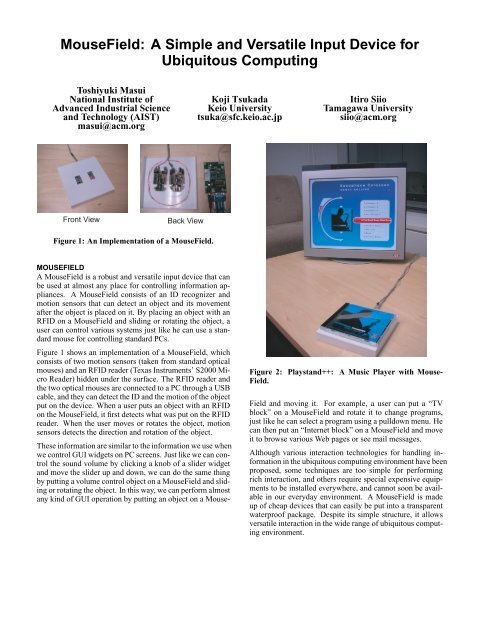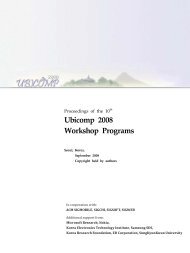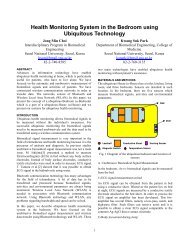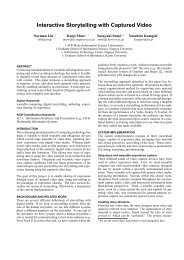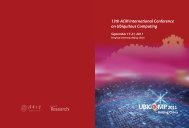A Simple and Versatile Input Device for Ubiquitous ... - UbiComp
A Simple and Versatile Input Device for Ubiquitous ... - UbiComp
A Simple and Versatile Input Device for Ubiquitous ... - UbiComp
Create successful ePaper yourself
Turn your PDF publications into a flip-book with our unique Google optimized e-Paper software.
MouseField: A <strong>Simple</strong> <strong>and</strong> <strong>Versatile</strong> <strong>Input</strong> <strong>Device</strong> <strong>for</strong><strong>Ubiquitous</strong> ComputingToshiyuki MasuiNational Institute ofAdvanced Industrial Science<strong>and</strong> Technology (AIST)masui@acm.orgKoji TsukadaKeio Universitytsuka@sfc.keio.ac.jpItiro SiioTamagawa Universitysiio@acm.orgFront ViewBack ViewFigure 1: An Implementation of a MouseField.MOUSEFIELDA MouseField is a robust <strong>and</strong> versatile input device that canbe used at almost any place <strong>for</strong> controlling in<strong>for</strong>mation appliances.A MouseField consists of an ID recognizer <strong>and</strong>motion sensors that can detect an object <strong>and</strong> its movementafter the object is placed on it. By placing an object with anRFID on a MouseField <strong>and</strong> sliding or rotating the object, auser can control various systems just like he can use a st<strong>and</strong>ardmouse <strong>for</strong> controlling st<strong>and</strong>ard PCs.Figure 1 shows an implementation of a MouseField, whichconsists of two motion sensors (taken from st<strong>and</strong>ard opticalmouses) <strong>and</strong> an RFID reader (Texas Instruments’ S2000 MicroReader) hidden under the surface. The RFID reader <strong>and</strong>the two optical mouses are connected to a PC through a USBcable, <strong>and</strong> they can detect the ID <strong>and</strong> the motion of the objectput on the device. When a user puts an object with an RFIDon the MouseField, it first detects what was put on the RFIDreader. When the user moves or rotates the object, motionsensors detects the direction <strong>and</strong> rotation of the object.These in<strong>for</strong>mation are similar to the in<strong>for</strong>mation we use whenwe control GUI widgets on PC screens. Just like we can controlthe sound volume by clicking a knob of a slider widget<strong>and</strong> move the slider up <strong>and</strong> down, we can do the same thingby putting a volume control object on a MouseField <strong>and</strong> slidingor rotating the object. In this way, we can per<strong>for</strong>m almostany kind of GUI operation by putting an object on a Mouse-Figure 2: Playst<strong>and</strong>++: A Music Player with Mouse-Field.Field <strong>and</strong> moving it. For example, a user can put a “TVblock” on a MouseField <strong>and</strong> rotate it to change programs,just like he can select a program using a pulldown menu. Hecan then put an “Internet block” on a MouseField <strong>and</strong> moveit to browse various Web pages or see mail messages.Although various interaction technologies <strong>for</strong> h<strong>and</strong>ling in<strong>for</strong>mationin the ubiquitous computing environment have beenproposed, some techniques are too simple <strong>for</strong> per<strong>for</strong>mingrich interaction, <strong>and</strong> others require special expensive equipmentsto be installed everywhere, <strong>and</strong> cannot soon be availablein our everyday environment. A MouseField is madeup of cheap devices that can easily be put into a transparentwaterproof package. Despite its simple structure, it allowsversatile interaction in the wide range of ubiquitous computingenvironment.
placing a CD jacketstarts playing musicIf we use multiple MouseField devices, we can utilize them<strong>for</strong> conveying in<strong>for</strong>mation between locations. When we per<strong>for</strong>man operation on one MouseField <strong>and</strong> per<strong>for</strong>m anotheroperation on another MouseField, those series of operationscan be interpreted as cooperative tasks. For example, a personcan use one MouseField to tell the system that he wantsto retrieve some in<strong>for</strong>mation at the location, <strong>and</strong> use anotherMouseField to tell that he wants to convey the in<strong>for</strong>mationto the new location. In this case, virtual Drag <strong>and</strong> Drop (orsometimes called “Pick <strong>and</strong> Drop”[3]) can be per<strong>for</strong>med. Ifa person selects a TV program on a MouseField by using aTV block, he can bring the object to a different place withanother MouseField <strong>and</strong> use the object to see the rest of theprogram there. In this way, MouseField can enable variousinteraction techniques which were only available with special<strong>and</strong> fragile input/output devices.sliding the CD jacketrotating the CD jacketplays the next musicchanges the sound volumeFigure 3: Controlling the Music Player.PLAYSTAND++The PlaySt<strong>and</strong>++ system (Figure 2) shows how a user canenjoy music using a MouseField <strong>and</strong> CD jackets <strong>for</strong> controllingthe player. All the music in the CD are saved in amusic server, <strong>and</strong> an RFID tag is attached to each CD jacket.When a user places a CD jacket on the MouseField, a musicplayer is displayed on the screen, shows the contents ofthe CD, <strong>and</strong> starts playing the music. The user can changethe sound volume by rotating the CD jacket, <strong>and</strong> move tothe next or previous song by sliding the jacket to the frontor to the back (Figure 3). When the user removes the jacketfrom the MouseField, the sound stops <strong>and</strong> a screen saver isdisplayed on the screen. PlaySt<strong>and</strong>++ is not only very simpleto use, but it allows users to control various parameterswithout using special controllers.OTHER APPLICATIONSJust like a mouse can be used <strong>for</strong> various purposes, a Mouse-Field can be used <strong>for</strong> whatever purpose you like in the ubiquitouscomputing applications. It can be used <strong>for</strong> invokingan application (just like a mouse-click can invoke an application),controlling parameters (just like using sliders <strong>and</strong>menus), selecting objects (just like dragging a mouse cursor),transferring data (just like mouse-based drag <strong>and</strong> drop),etc.RELATED SYSTEMSFieldMouse[4] is a device which has the same configurationas MouseField: a FieldMouse consists of a motion sensingdevice <strong>and</strong> an ID recognizer. While MouseField is a deviceinstalled in tables <strong>and</strong> walls, FieldMouse is a device carriedby people to control various in<strong>for</strong>mation appliances. Advantagesof using a FieldMouse is that people can operate realworldGUI[2] without installing many sensors everywhere.A disadvantage of FieldMouse is that a user always has tocarry a FieldMouse to control in<strong>for</strong>mation appliances. Sincea FieldMouse consists of an ID recognizer <strong>and</strong> a motion sensor,it is always heavier than simple RFID tags.“Phicons”[1], or physical icons, are sometimes useful <strong>for</strong>h<strong>and</strong>ling in<strong>for</strong>mation in the ubiquitous computing environment.Using a MouseField, almost anything can be used asa phicon, if an RFID tag is put into it.CONCLUSIONSWe developed a simple, robust <strong>and</strong> flexible input device calledthe MouseField <strong>for</strong> controlling in<strong>for</strong>mation in the ubiquitouscomputing environment. Despite its simplicity, MouseFieldis flexible enough <strong>for</strong> h<strong>and</strong>ling complex in<strong>for</strong>mation at variousplaces where conventional input devices like keyboards<strong>and</strong> mouses were not conveniently used. We hope Mouse-Field will be one of the st<strong>and</strong>ard input devices used in theubiquitous computing age.REFERENCES[1] Hiroshi Ishii <strong>and</strong> Brygg Ullmer. Tangible Bits: Towards seamlessinterfaces between people, bits <strong>and</strong> atoms. In Proceedings of the ACMConference on Human Factors in Computing Systems (CHI’97), pages234–241. Addison-Wesley, April 1997.[2] Toshiyuki Masui <strong>and</strong> Itiro Siio. Real-world graphical user interfaces.In Peter Thomas <strong>and</strong> Hans W. Gellersen, editors, Proceedings of theFirst International Symposium on H<strong>and</strong>held <strong>and</strong> <strong>Ubiquitous</strong>Computing, number 1927 in Lecture Notes in Computer Science,pages 72–84. Springer-Verlag, September 2000.[3] Jun Rekimoto. Pick-<strong>and</strong>-Drop: A direct manipulation technique <strong>for</strong>multiple computer environments. In Proceedings of the ACMSymposium on User Interface Software <strong>and</strong> Technology (UIST’97),pages 31–39. ACM Press, November 1997.[4] Itiro Siio, Toshiyuki Masui, <strong>and</strong> Kentaro Fukuchi. Real-worldinteraction using the FieldMouse. In Proceedings of the ACMSymposium on User Interface Software <strong>and</strong> Technology (UIST’99),pages 113–119. ACM Press, November 1999.


